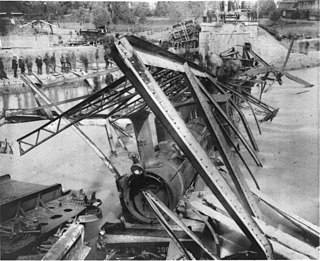
The Baikal–Amur Mainline is a 1,520 mm broad-gauge railway line in Russia. Traversing Eastern Siberia and the Russian Far East, the 4,324 km (2,687 mi)-long BAM runs about 610 to 770 km north of and parallel to the Trans-Siberian Railway.

Bryansk Oblast, also known as Bryanshchina, is a federal subject of Russia. Its administrative center is the city of Bryansk. As of the 2021 Census, its population was 1,169,161.

Bryansk is a city and the administrative center of Bryansk Oblast, Russia, situated on the River Desna, 379 kilometers (235 mi) southwest of Moscow. Population: 379,152 (2021 Census); 415,721 (2010 Census); 431,526 (2002 Census); 452,160 (1989 Census).

The Selby rail crash was a high-speed rail crash that occurred at Great Heck near Selby, North Yorkshire, England, on the morning of 28 February 2001. An InterCity 225 passenger train operated by Great North Eastern Railway (GNER) travelling from Newcastle to London collided with a Land Rover Defender which had crashed down a motorway embankment onto the railway line. It was consequently derailed into the path of an oncoming freight train, colliding at an estimated closing speed of 142 mph (229 km/h). Ten people were killed, including the drivers of both trains, and 82 were seriously injured. It remains the worst rail disaster of the 21st century in the United Kingdom.

St Johns railway station is in the London Borough of Lewisham. It lies 5 miles 47 chains (9.0 km) down the South Eastern Main Line from London Charing Cross, and is situated between New Cross and Lewisham.
The Ufa train disaster was a railway accident that occurred on 4 June 1989, in Iglinsky District, Bashkir ASSR, Russian SFSR, Soviet Union, when an explosion killed 575 people and injured 800 more. It is the deadliest rail disaster during peacetime in Soviet/Russian history and the second-deadliest overall after the Vereshchyovka train disaster.

The Spanish River derailment was a rail transport accident that occurred on 21 January 1910, on the Canadian Pacific Railway (CPR) Webbwood Subdivision, where the railway crosses the Spanish River near the settlement of Nairn near Sudbury, Ontario, Canada. A westbound passenger express train derailed and crashed into the Spanish River bridge, killing at least 43 passengers, though the death count varies. The cause was never established, but was believed to be poor track condition and/or speeding and braking on a curve.

The Shipton-on-Cherwell train crash was a major disaster which occurred on the Great Western Railway. It involved the derailment of a long passenger train at Shipton-on-Cherwell, near Kidlington, Oxfordshire, England, on Christmas Eve, 24 December 1874, and was one of the worst disasters on the Great Western Railway.

The Sonning Cutting railway accident occurred during the early hours of 24 December 1841 in the Sonning Cutting through Sonning Hill, near Reading, Berkshire. A Great Western Railway (GWR) luggage train travelling from London Paddington to Bristol Temple Meads station entered Sonning Cutting. The train was made up of the broad-gauge locomotive Hecla, a tender, three third-class passenger carriages, and some heavily laden goods waggons. The passenger carriages were between the tender and the goods waggons.

The Münchenstein rail disaster on 14 June 1891 was historically the worst railway accident ever to affect Switzerland. A crowded passenger train fell through a girder bridge, killing more than seventy people and injuring many others. The accident occurred on the railway line between Basel and Delémont, near the Bruckgut just below the village centre of Münchenstein, as the train was traversing the bridge across the river Birs.
A washaway is a particular kind of landslide that can affect man-made structures such as cuttings, embankments and bridges. They are thus a hazard to railways and road traffic.

The Getå Railroad Disaster was a train disaster caused by a landslide in Getå, a town that is now part of the municipality of Norrköping on 1 October 1918. To date, it is the worst rail accident in Swedish history.

The Chernihiv–Ovruch railway is a partially electrified and partially operational single track railway line that stretches between the town of Ovruch and the city of Chernihiv, in northern Ukraine, passing through southern Belarus and the Chernobyl Exclusion Zone. The line is owned by Ukrzaliznytsia alone, with railway stations located in Belarus being leased from the government of Belarus. A portion of the line between railway stations Vilcha and Semykhody has not been in service since the Chernobyl disaster, on 26 April 1986.
The rail war began in different regions of Russia in the spring of 2022 after a similar rail war in Belarus.











